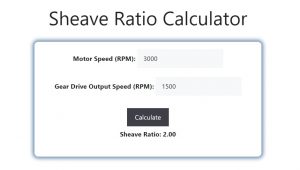About Sheave Ratio Calculator (Formula)
The Sheave Ratio Calculator is an essential tool for engineers and technicians working with pulley systems and gear drives. It helps determine the relationship between the speed of a motor and the output speed of a gear drive, allowing for efficient system design and optimization. Understanding the sheave ratio is crucial for ensuring that machines operate effectively, especially in applications involving power transmission and motion control.
Formula
The formula for calculating the sheave ratio is:
Sheave Ratio = Motor Speed / Gear Drive Output Speed
In this formula, Motor Speed refers to the rotational speed of the motor, while Gear Drive Output Speed indicates the speed at which the output gear is turning.
How to Use
Using the Sheave Ratio Calculator is simple. Follow these steps to achieve accurate results:
- Collect Your Data: Obtain the necessary parameters, including Motor Speed and Gear Drive Output Speed.
- Input Values: Enter the values for Motor Speed and Gear Drive Output Speed into the calculator.
- Calculate the Sheave Ratio: Click the calculate button to determine the sheave ratio.
- Review Results: Analyze the calculated sheave ratio to understand the relationship between the motor and gear drive speeds.
Example
Let’s consider an example to illustrate the use of the Sheave Ratio Calculator:
- Motor Speed: 3000 RPM
- Gear Drive Output Speed: 1500 RPM
- Use the Formula:
Sheave Ratio = Motor Speed / Gear Drive Output Speed
Sheave Ratio = 3000 RPM / 1500 RPM
Sheave Ratio = 2
In this example, the sheave ratio is 2, indicating that the motor speed is twice that of the gear drive output speed.

FAQs
- What is a sheave ratio?
The sheave ratio is the ratio of the motor speed to the output speed of a gear drive, indicating how much faster the motor turns compared to the gear output. - Why is the sheave ratio important?
It is crucial for ensuring proper power transmission and performance in mechanical systems involving pulleys and gears. - What units are used for measuring speed in this calculation?
Speed can be measured in RPM (revolutions per minute) or any consistent unit of rotational speed. - Can the sheave ratio be less than 1?
Yes, a sheave ratio of less than 1 indicates that the gear drive output speed is greater than the motor speed. - How can I improve the sheave ratio in my system?
Modifying pulley sizes, gear ratios, or motor speeds can improve the sheave ratio to achieve desired performance. - Is there an ideal sheave ratio for all applications?
No, the ideal sheave ratio depends on the specific requirements and design of the mechanical system. - What happens if the sheave ratio is too high?
A high sheave ratio can lead to excessive wear, reduced efficiency, and potential mechanical failure. - How can I measure motor and gear drive speeds?
Use tachometers or speed sensors to accurately measure the rotational speeds of motors and gear drives. - What industries utilize sheave ratio calculations?
Industries such as manufacturing, automotive, and robotics commonly use sheave ratio calculations for mechanical design. - Can the sheave ratio indicate system inefficiencies?
Yes, an inappropriate sheave ratio can indicate inefficiencies, leading to increased energy consumption and wear. - How does the sheave ratio affect torque?
The sheave ratio affects the torque output of the system; a higher ratio can increase torque at the cost of speed. - Are there online calculators available for sheave ratio calculations?
Yes, several online calculators can assist with sheave ratio calculations for different mechanical applications. - What factors can affect the sheave ratio?
Factors include pulley diameters, gear ratios, and the mechanical design of the system. - How do I choose the right motor speed for my application?
Consider the desired output speed, torque requirements, and system efficiency when selecting motor speed. - Can I use the sheave ratio for belt drive systems?
Yes, the sheave ratio concept is applicable to both belt and chain drive systems. - What is the relationship between sheave ratio and power output?
The sheave ratio affects the power output; optimizing the ratio can improve overall system performance. - How often should I check the sheave ratio in my systems?
Regular monitoring is recommended, especially in critical applications to ensure optimal performance. - Is the sheave ratio affected by wear and tear?
Yes, wear and tear on pulleys and gears can alter the effective sheave ratio over time. - Can I calculate the sheave ratio without specific equipment?
Yes, you can calculate it using basic RPM measurements, but precision tools will yield more accurate results. - What safety precautions should I take when working with sheave systems?
Ensure proper guarding, regular maintenance checks, and follow manufacturer guidelines to enhance safety when working with sheave systems.
Conclusion
The Sheave Ratio Calculator is a valuable tool for engineers and technicians, helping to determine the efficiency of pulley and gear systems. By understanding the sheave ratio, users can optimize their systems for better performance and energy efficiency. This calculator plays a vital role in the design, analysis, and improvement of mechanical applications across various industries, ensuring that machines operate effectively and reliably.